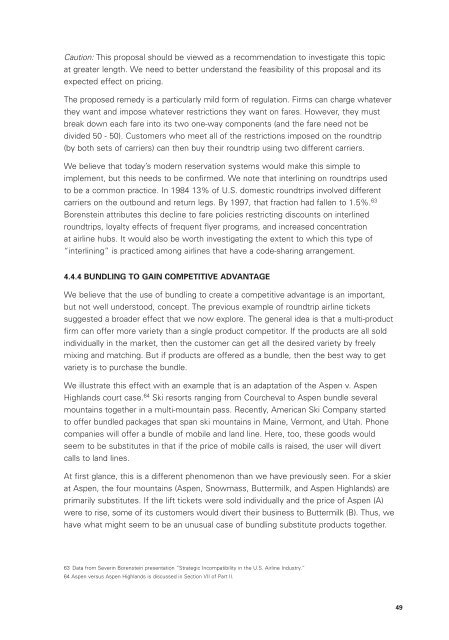Bundling, Tying, and Portfolio Effects: Part 1 Conceptual Issues
Bundling, Tying, and Portfolio Effects: Part 1 Conceptual Issues
Bundling, Tying, and Portfolio Effects: Part 1 Conceptual Issues
You also want an ePaper? Increase the reach of your titles
YUMPU automatically turns print PDFs into web optimized ePapers that Google loves.
Caution: This proposal should be viewed as a recommendation to investigate this topic<br />
at greater length. We need to better underst<strong>and</strong> the feasibility of this proposal <strong>and</strong> its<br />
expected effect on pricing.<br />
The proposed remedy is a particularly mild form of regulation. Firms can charge whatever<br />
they want <strong>and</strong> impose whatever restrictions they want on fares. However, they must<br />
break down each fare into its two one-way components (<strong>and</strong> the fare need not be<br />
divided 50 - 50). Customers who meet all of the restrictions imposed on the roundtrip<br />
(by both sets of carriers) can then buy their roundtrip using two different carriers.<br />
We believe that today’s modern reservation systems would make this simple to<br />
implement, but this needs to be confirmed. We note that interlining on roundtrips used<br />
to be a common practice. In 1984 13% of U.S. domestic roundtrips involved different<br />
carriers on the outbound <strong>and</strong> return legs. By 1997, that fraction had fallen to 1.5%. 63<br />
Borenstein attributes this decline to fare policies restricting discounts on interlined<br />
roundtrips, loyalty effects of frequent flyer programs, <strong>and</strong> increased concentration<br />
at airline hubs. It would also be worth investigating the extent to which this type of<br />
“interlining” is practiced among airlines that have a code-sharing arrangement.<br />
4.4.4 BUNDLING TO GAIN COMPETITIVE ADVANTAGE<br />
We believe that the use of bundling to create a competitive advantage is an important,<br />
but not well understood, concept. The previous example of roundtrip airline tickets<br />
suggested a broader effect that we now explore. The general idea is that a multi-product<br />
firm can offer more variety than a single product competitor. If the products are all sold<br />
individually in the market, then the customer can get all the desired variety by freely<br />
mixing <strong>and</strong> matching. But if products are offered as a bundle, then the best way to get<br />
variety is to purchase the bundle.<br />
We illustrate this effect with an example that is an adaptation of the Aspen v. Aspen<br />
Highl<strong>and</strong>s court case. 64 Ski resorts ranging from Courcheval to Aspen bundle several<br />
mountains together in a multi-mountain pass. Recently, American Ski Company started<br />
to offer bundled packages that span ski mountains in Maine, Vermont, <strong>and</strong> Utah. Phone<br />
companies will offer a bundle of mobile <strong>and</strong> l<strong>and</strong> line. Here, too, these goods would<br />
seem to be substitutes in that if the price of mobile calls is raised, the user will divert<br />
calls to l<strong>and</strong> lines.<br />
At first glance, this is a different phenomenon than we have previously seen. For a skier<br />
at Aspen, the four mountains (Aspen, Snowmass, Buttermilk, <strong>and</strong> Aspen Highl<strong>and</strong>s) are<br />
primarily substitutes. If the lift tickets were sold individually <strong>and</strong> the price of Aspen (A)<br />
were to rise, some of its customers would divert their business to Buttermilk (B). Thus, we<br />
have what might seem to be an unusual case of bundling substitute products together.<br />
63 Data from Severin Borenstein presentation “Strategic Incompatibility in the U.S. Airline Industry.”<br />
64 Aspen versus Aspen Highl<strong>and</strong>s is discussed in Section VII of <strong>Part</strong> II.<br />
49

















